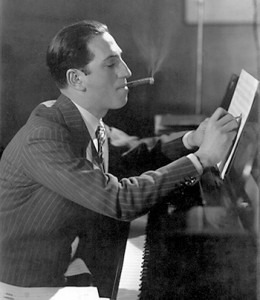 “Minors of the Majors” invites you to discover compositions by the great classical composers that for one reason or another have not reached the musical mainstream. Please enjoy, and keep listening!
“Minors of the Majors” invites you to discover compositions by the great classical composers that for one reason or another have not reached the musical mainstream. Please enjoy, and keep listening!
The son of poor Jewish immigrants, George Gershwin, could hardly have dreamt that his Rhapsody in Blue would single-handedly propel him to world fame. Within a couple of years of the premier performance on February 12, 1924, several million copies of the recording had been sold, and when Gershwin traveled to Vienna in 1928, the house orchestra at the famous Café Sacher spontaneously played the opening of the Rhapsody in Blue as he entered. Gershwin claimed to have composed “a sort of musical kaleidoscope of America, of our vast melting pot, of our unduplicated national pep, of our blues, our metropolitan madness.” Gershwin’s musical smorgasbord of combining elements from classical music with jazz influences fuelled a deep infatuation with American popular musical styles on the European musical landscape. And in 1926, he followed up with his Three Preludes.
A Vanity Fair article in March 1925 claimed, “Gershwin was working on a suite of twenty-four piano preludes, to be called “The Melting Pot.” In the end, Gershwin published only three piano preludes during his short lifetime. On 4 December 1926, Gershwin gave a joint recital at the Hotel Roosevelt with an English/Peruvian contralto named Marguerite d’Alvarez. The concert was to be an experimental juxtaposition of highbrow and popular music, with d’Alvarez singing art songs and then Broadway numbers. Gershwin premiered his two-piano version of Rhapsody in Blue, and five preludes for solo piano. When the concert was repeated on 16 January 1927, the composer played not five but six preludes! This sixth prelude is sometimes called “the lost prelude,” and may well be based on a 1924 sketch.
Be that as it may, the blues decisively influences the “Allegro ben ritmato e deciso,” and the syncopated rhythms provide a strong jazz feel. A seductive melody above a smooth and steady bass-line initiates the second Prelude. Gershwin himself referred to this piece as “a sort of blues lullaby,” and after a highly contrasting middle section, this prelude returns to the opening materials. Marked “Agitato,” the final prelude, which Gershwin called “Spanish,” features a brief and dramatic introduction followed by a pair of contrasting melodies.
George Gershwin: Three Preludes
You May Also Like
- Minors of the Majors
Charles-Camille Saint-Saëns: Cello Concerto No. 2 in D minor, Op. 119 Camille Saint-Saëns was one of the greatest of all music prodigies. - Minors of the Majors
Max Bruch: Concerto for Clarinet and Viola in E minor, Op. 88 Celebrating his 75th birthday in 1906, the legendary violinist Joseph Joachim declared that Germany had four great violin concertos. - Minors of the Majors
Dimitri Shostakovich: Suite for Variety Orchestra In the immediate aftermath of WWI, Western Europe fell under the spell of popular American musical styles. - Minors of the Majors
Johannes Brahms: Piano Trio in A Major, Op. posth. Johannes Brahms was an uncompromising perfectionist.
More Anecdotes
- Bach Babies in Music
Regina Susanna Bach (1742-1809) Learn about Bach's youngest surviving child - Bach Babies in Music
Johanna Carolina Bach (1737-81) Discover how family and crisis intersected in Bach's world - Bach Babies in Music
Johann Christian Bach (1735-1782) From Soho to the royal court: Johann Christian Bach's London success story - A Tour of Boston, 1924
Vernon Duke’s Homage to Boston Listen to pianist Scott Dunn bring this musical postcard to life
